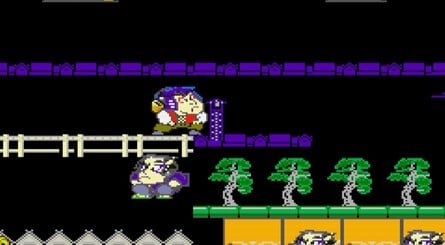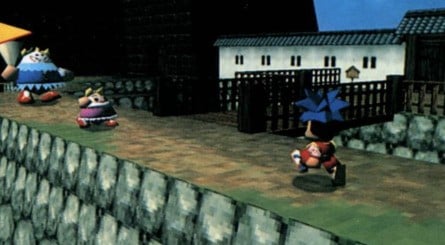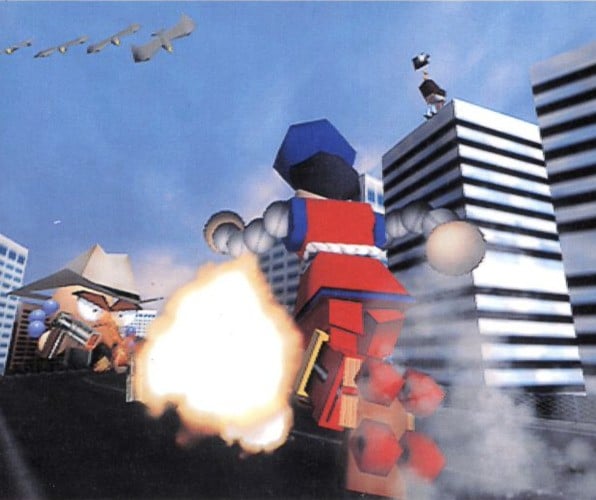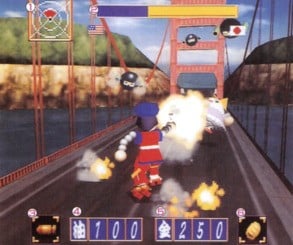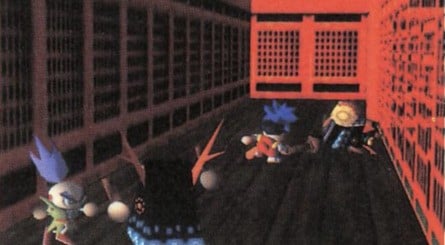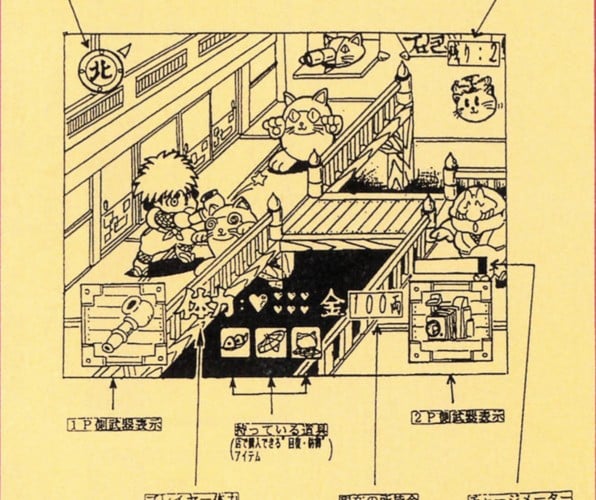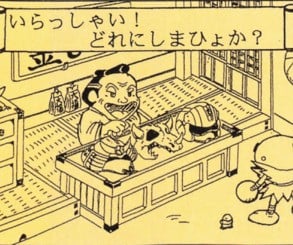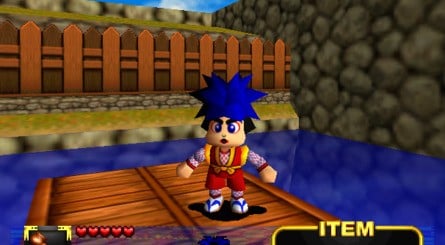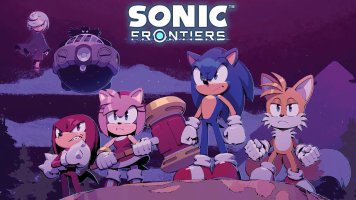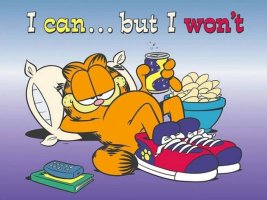Part of Konami's long-running and infrequently localized Ganbare Goemon series, it saw players take control of a blue-haired, pipe-wielding hero named Goemon (who is loosely based on the 16th-century noble thief Ishikawa Goemon) and his group of friends (Ebisumaru, Yae, and Sasuke), as they do battle against the Peach Mountain Shoguns — a gang of stage performers intent on turning Japan into a Western-style theatre.
At the time of its Western release, the game was described as a mix of Super Mario 64 and The Legend of Zelda, and we can somewhat understand these comparisons. The game controls like a traditional 3D platformer like Mario, while also requiring players to visit various small villages to stock up on items before completing challenging dungeons similar to Zelda. But what this analogy doesn't seem to cover are the game's giant robot battles, catchy anime-style theme songs, and the ridiculous humour sprinkled throughout. These are the elements that continue to set it apart from the rest of its contemporaries.
For years, we've been curious to learn more about the story of the game's development, but a lot of the information we've been seeking has sadly only ever been made available in Japanese, with Konami only doing a small number of English interviews to promote the game. So we recently enlisted the help of Stephen Meyerink, a Japanese-to-English translator, to help us crack open a vault of never-before-translated interviews to learn more about the development of this often-overlooked classic. Before we get into all that good stuff, though, we first have to take a quick detour to briefly go over the history of the series, just to give you some more context about the game.
A Brief History of Goemon Games (Pre-Mystical Ninja)
Konami's Ganbare Goemon series dates all the way back to 1986 and has its origins in two games. The first is Mr. Goemon, an arcade title that saw players travelling across Japan battling ninjas and samurai, to steal from the rich and give to the poor, and the second is the top-down Famicom adventure game Ganbare Goemon Karakuri Dōchū, which was developed by a different team inside Konami.From here, the game later went on to spawn a small collection of Famicom sequels and spin-offs, before making its debut on the Super Famicom in 1991 with Ganbare Goemon: Yukihime Kyūshutsu Emaki — a game that would eventually become the first to be localized in the series under the name The Legend of the Mystical Ninja. This localization would controversially see the names of Goemon and his stubby partner Ebisumaru being changed to Kid Ying and Dr. Yang (Japanese food items would also be switched from things like onigiri rice balls to pizzas and hamburgers to make it more westernized) but would go on to become critically acclaimed receiving excellent reviews from magazines like Total!, Super Play, and Nintendo Power.
Mr. Goemon (top left), Ganbare Goemon Karakuri Dōchū (top right), The Legend of the Mystical Ninja (bottom left) and Ganbare Goemon 2: Kiteretsu Shōgun Magginesu (bottom right) — Images: Konami
Following the warm reception to The Legend of the Mystical Ninja in the West, you might expect that its subsequent sequels and spin-offs for the Super Famicom would have also launched overseas to further establish the series outside of Japan, but sadly this was not to be. Instead, players had to make do with reading about the games in magazines or if they were lucky, picking them up on import and trying to persevere despite the language barrier. While the Ganbare Goemon series continued to evolve and receive new games, most Western gamers probably had no idea the series was still active, simply assuming The Legend of the Mystical Ninja was a glorious one-off. Meanwhile, in Japan, a team was assembling to bring the series to Nintendo's new 64-bit system.
The Switch to 3D
News of a Ganbare Goemon game for the N64 was shared as early as September 1996 in the pages of Famimaga 64, under the title Ganbare Goemon 5, with Konami revealing a number of pre-rendered images of Goemon, Yae, Ebisumaru, and Sasuke, alongside some potential locations players would visit including Mt. Fuji (from the final game) and a scrapped American level featuring the giant robot Impact. Throughout the year, more information would trickle out, with a couple of Japanese publications later interviewing key personnel like the game's director Etsunobu Ebisu, and the planner Keita Kawaminami about the current state of the development and taking the series into 3D.Ebisu had previously worked as a programmer on Ganbare Goemon 2 for the original Famicom, and had gone on to direct the Super Famicom titles Ganbare Goemon 2: Kiteretsu Shogun Magginesu, Ganbare Goemon 3: Shishi Jūrokubē no Karakuri Manjigatame, and Ganbare Goemon Kirakira Dōchū: Boku ga Dancer ni Natta Wake (otherwise known as Ganbare Goemon 4). He was also notably the inspiration for the look of Goemon's sidekick Ebisumaru, who appears as a playable character in many Ganbare Goemon games.
Keita Kawaminami, on the other hand, was primarily involved with the Famicom titles, contributing to many of those titles as a designer. For this project, he took over the role from Koichi Ogawa, who had been the planner on three of the Super Famicom titles and would later leave Konami for Square to design 1998's Brave Fencer Musashi.The game is basically set up like if Goemon 3 were made into 3D. But I think that the 3D element makes the ambiance and vibe of the game that users will experience pretty different.
It was during these conversations with the press that Ebisu revealed some more details about the direction of the project, announcing that the game was primarily influenced by the gameplay of Ganbare Goemon 3: Shishi Jūrokubē no Karakuri Manjigatame.
As he told Famimaga 64 in November 1996, "The game is basically set up like if Goemon 3 were made into 3D. But I think that the 3D element makes the ambiance and vibe of the game that users will experience pretty different." Asked about whether the team was aware of Super Mario 64 at all and whether Goemon would play similarly, Ebisu stated, "We're aware of it in the sense of it having fundamentally the same sort of action elements, but from a gameplay perspective, Goemon games tend to involve more outright "attacking" your enemies, so we're hoping to find the fun in that area."
Early press shots showed a "lost" Impact level featuring a USA vs. Japan theme — Images: Konami
Kawamini, meanwhile, added, "Basically, you could think of the game as being centered around story-related objectives, where you solve puzzles as you travel around, like figuring out how to get into the castles. And then, once you do find your way into a castle, you fight off enemies as you make your way to boss areas. Those are the sort of two styles of gameplay we're thinking in terms of. So with Mario 64, the entire game is built around the hunt for stars, whereas Goemon will be structured around solving puzzles and defeating enemies — and that's how we're trying to differentiate our game."
Map Designs, Mocap, & Multiplayer
During development, the team placed a major emphasis in the press on three particular elements. The first of these was the game's portrayal of Japan, with Ebisu telling Famimaga 64's reporters that the team was "focused on building a world dripping with Japanese style, not one with Western or mechanical influences or those sorts of things." As he stated, "We're wanting to get back to the roots of the Goemon games with this one. That is, we're trying to provide the fun of traveling around to all sorts of places that you could find in classic Goemon titles, so we hope you look forward to that, too."These two quotes are likely a reference to the last couple of games in the Ganbare Goemon series that featured plots about time travel and Goemon's adventures in outer space. With Ganbare Goemon 5, the intent was to focus on a more traditional adventure, similar to that seen in Ganbare Goemon: Yukihime Kyūshutsu Emaki, and Ganbare Goemon 2: Kiteretsu Shogun Magginesu, as well as the original Famicom adventures.
Here are some of the press shots published by outlets like Famimaga 64 showing the scrapped cooperative multiplayer feature — Images: Konami
In another interview with the publication Dengeki 64, dated November 1996, Ebisu brought up the game's portrayal of the game's first dungeon based on Edo castle, as an example of the incredible work the team had done to replicate historical locations, claiming it had been "recreated in gorgeous graphics" and that players "should be able to enjoy some excitement even just from walking around that field area".
Besides the boasts of replicating several Japanese locations in 3D, another important talking point was the use of mocap for the animations in the game, with Ebisu saying at the time that each of the four playable characters featured roughly 100 animations. In a February 1997 interview with Famimaga 64, Ebisu even went so far as to claim, "I'd bet you could even have fun just watching the way the characters move and animate. That's especially true of Ebisumaru—everything about how he moves is just SO evocative of his character! He moves in such an expressive way... And he does it SO much! (laughs)"
Ganbare Goemon 5 concept art. Note the depiction of the scrapped multiplayer mode (left) and the cut Impact stage set in the US (bottom right) — Images: Konami
Perhaps the most significant feature teased, however, in the lead-up to the release was the presence of co-operative multiplayer — something that was a feature of earlier Ganbare Goemon games but proved to be a headache for the team to implement in 3D. From screenshots shown in early coverage of the game, the multiplayer was always depicted as two players moving around a single screen, but the team did at one point seem to consider introducing a split-screen option to potentially allow for a greater set of gameplay possibilities. In a conversation with Famimaga 64 in February 1997, Kawamini brought up this possibility, leading to the interviewer bringing up the idea of potentially playing games like tag with their friends across the world map.
"I think there would be a lot of possibilities if we were to go that route. ," said Kawamini, "After all, if the two players could act independently of one another like that, they'd have that much more freedom."
Images: Konami
So important was this feature that Ebisu told Dengeki 64 in 1996, "The Goemon series is developed with the concept of being 'communication software in which you have a lively fun time with friends or family.' As such, the two-player simultaneous player is an incredibly essential element for a Goemon game." But he also admitted that it was causing a lot of trouble to get working in a 3D environment, stating "We decided relatively lightly early on in planning to do it, but as development has progressed, problems have continued to crop up one after another (laughs)."
We spoke to a member of the Ganbare Goemon 5's development team back in 2022 under the condition of anonymity and they gave us a bit more insight into these challenges, "Developing a 3D system in a short time frame was incredibly hard, to say the least, due to a lack of reference materials and examples to work from. The company wanted us to develop everything in such a short period of time, and so as a result, I wasn't very satisfied because I felt everything we did was a series of rush jobs."
The Rocky Road To Release
With all of this in mind, it's probably no surprise, then, that the multiplayer was eventually scrapped with the game re-debuting around the Tokyo Game Show, in April 1997, as a single-player game. Multiplayer had just been too ambitious for the team to pull off, especially when they were racing against a ticking clock, so it was put aside, with the hope that it could be revisited in future 3D titles. The emphasis instead fell on making something they could ship and ironing out many of the bugs that had started to crop up with the 3D engine.On May 28th, 1997, Konami announced Ganbare Goemon 5 would be hitting Japanese store shelves later that year, and that the game would be released on a 128 mega ROM cartridge — perfect for squeezing a bunch of high-quality voice samples and three musical numbers Theme of Ganbare Goemon, I Am Impact, and Gorgeous My Stage into the final product.
Early impressions of demos of the game, however, were anything but complimentary. In the June 1997 issue of Computer & Video Games magazine, Warren Herrod, for instance, previewed the version of the game shown at the Tokyo Game Show earlier that year and came away disappointed at just how many issues were still yet to be overcome.
In the magazine, Herrod wrote, "There are two main problems [with Goemon 5] - firstly the main game engine is not complete. Not only does the game have a tendency to crash (it froze up several times and needed to be reset), there are all sorts of clipping problems with the polygons." He claimed he was shocked Konami "had the nerve to wheel Goemon 5 out before the public in this sorry state" and compared it negatively to Mario 64.
These same issues seemed to persist in the build that was shown off in June 1997 at E3, with IGN's Peer Schneider similarly surmising, "The game is...earlier than we thought, with collision detection, polygonal glitches, character movement and, most importantly, inconsistent camera angles making the game seem like a less than brilliant Mario copy." However, Schneider seemed much more enthusiastic about the potential for the game, thanks in part to his personal excitement over Konami announcing that it would be localized and released in North America and Europe.The game is...earlier than we thought, with collision detection, polygonal glitches, character movement and, most importantly, inconsistent camera angles making the game seem like a less than brilliant Mario copy
Speaking to Time Extension, Schneider told us, "By the time Goemon 64 was announced I had played every SNES Goemon game, moved to the US, and written an article about how Mystical Ninja's localization would live on in infamy. Given that none of its sequels were released outside Japan, I was expecting to get my copy via a local import shop — but was pleasantly surprised Konami was bringing it stateside. The good news didn't stop there either: I still remember Konami's US PR rep telling me that they'd keep the original Japanese names intact [in other words, no more Kid Ying and Dr. Yang]."
The Legacy of The Mystical Ninja Starring Goemon
After a particularly long, complicated, and arduous development cycle, Ganbare Goemon 5 was eventually released in Japan under the name Ganbare Goemon: Neo Momoyama Bakufu no Odori in August 1997 and ended up receiving a score of 28/40 from a panel of four Famitsu reviewers in Issue 452 of the magazine. The localized version of the game — Mystical Ninja Starring Goemon — would arrive in North American and UK stores less than one year later, meanwhile, in April 1998, provoking mixed reactions from the gaming media.N64 Magazine in the UK, for example, gave it 90%, praising its bosses as "an astronomical leap" from the SNES and NES versions and calling its graphics "impressively expert". It described it as "just the ticket for N64 owners awaiting a bridge between Mario 64 and its sequel, and a perfect example of how well the machine can be used by third-party developers." Gamespot's Peter Bartholow, on the other hand, gave it a more conservative 6.7 out of 10. Bartholow called the experience of playing the N64 title "a digital culture shock" and concluded that "everything from Japanese architecture to religious practices somehow becomes an issue in playing Mystical Ninja". An example he gave was the first room of the game, where the folding doors may potentially look like walls to your average American, leading some players to get stuck.
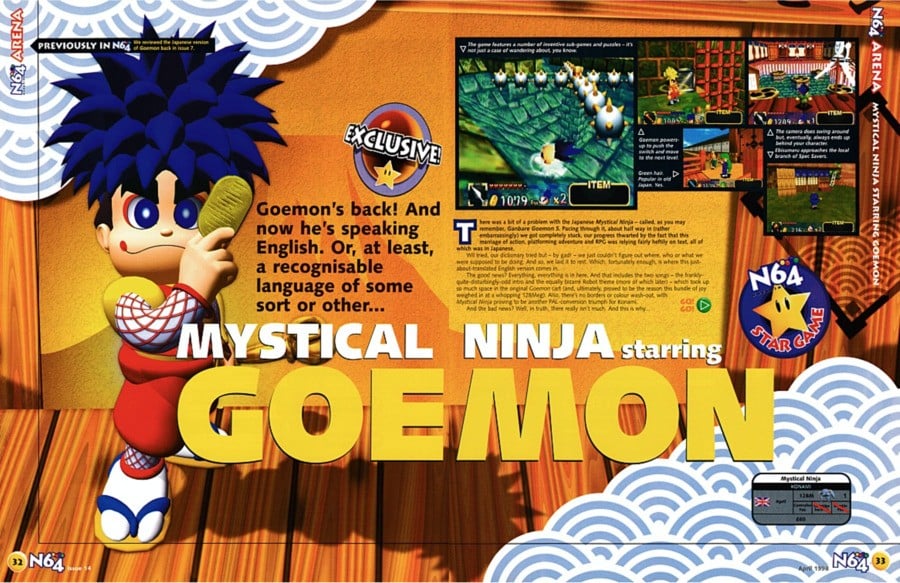 Image: N64 Magazine
Image: N64 MagazineNevertheless, despite these concerns, the game has gone on to generate a sizable fanbase in the West, which includes Jingleboy from the Goemon fansite Goemon International, and the researcher/Twitter user Project Goemon.
"The game was unlike anything I'd played before," Jingleboy told us. "The setting, the music, the giant robot fights - I experienced it at an impressionable age and it introduced me to the world of Japan which I'd never really been aware of as a kid. Needless to say, it has stuck with me ever since. Whether it has the best gameplay in the Goemon series may be debatable to some, but none can deny the impact it had on introducing people to the series back in the 90s."
Project Goemon, meanwhile, told us, "What really appeals to me about Mystical Ninja Starring Goemon is that it feels like a unique dollhouse expanded into a maquette of a mini Edo-era Japan, with distinctive characters and fantastic locations. There are many comedy scenes and scripted, sometimes convoluted, events in the game, but unlike other Goemon games, it feels more like an earnest adventure. Discussions about the Zelda series often bring up the narrative that Miyamoto conceived the idea for the first Zelda by recalling the sense of adventure he experienced as a child, discovering new areas in the woods where he played.
"Whether due to the novelty of 3D or the way the story was written, that's precisely what Mystical Ninja Starring Goemon feels like: a more personal journey for the player, punctuated with moments of comedy and whimsy, all enveloped in an aura of wonder and mystery. Some of the most memorable moments for me in this game are those quiet, evocative moments of simply looking at the winter moon or staring at kites flying over a green field."
To coincide with the release of Mystical Ninja Starring Goemon in the West, Konami localized the Game Boy title Ganbare Goemon: Kurofune Tō no Nazo (again under the title "Mystical Ninja Starring Goemon") and released it within the same month. It then followed this up by bringing its 1998 sequel Ganbare Goemon: Derodero Dōchū Obake Tenkomori to the West (under the name Goemon's Great Adventure in North America and Mystical Ninja 2 Starring Goemon in Europe) in 1999. It seemed like Konami was finally investing money into making the series catch on overseas, but then all of a sudden, everything stopped.
As more games were released in the Ganbare Goemon series in Japan over the next seven years, Konami decided against providing further localizations for these titles, leading most people in North America and Europe to be unaware of these other adventures and what they were missing out on.
When we asked a former Konami/Ganbare Goemon 5 developer why they thought this was the case back in 2022, they told us, "With the games essentially being stories that take place during the Edo period, they're products for the Japanese market. In fact, each game was released at the end of the year so that players could enjoy it during the New Year holidays. Some of the games were localized, but they weren't hits the way they were in Japan."
In 2005, Konami ended up releasing Ganbare Goemon: Tōkai Dōchū Ōedo Tengu ri Kaeshi no Maki for the Nintendo DS, which became the last "proper" title to be launched in the series (discounting the pair of Pachislots titles). This has left fans hoping for a revival of the series, or for some the older games that are currently unavailable to be reissued officially on modern consoles. It's currently unknown whether Konami's blue-haired hero will ever ride again, but like many of its overseas fans, we'll keep banging the drum in the hopes that it may one day make a difference.



